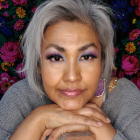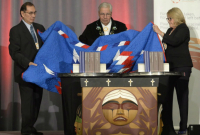Support strong Canadian climate journalism for 2025
I watched the livestream of the Pope's apology with a piece of broken brick by my side.
The red clay brick is from my former residential school.
I am sure people will wonder why I have it.
The reason is simple: it is a reminder of Canada's assimilation policy and how residential schools impacted generations of Indigenous people, including my family.
However, like this brick, I am still here.
I am a remnant of the past.
The last in my family to attend a residential school.
In fact, four generations of my family attended the same residential school in Lebret, Sask. It operated for 114 years and was demolished in 2000.
I returned to the school grounds for the first time in the summer of 2020. While standing on the very spot the school once stood, I noticed something familiar.
I picked up the broken brick and have kept it with me ever since.
Like this brick, parts of me are broken.
But like this brick, I remain — the physical proof these schools existed.
It’s taken me many years to get to this point.
I know it’s my responsibility to carry forward the stories of survivors.
There is still so much misinformation circulating about residential schools.
The last one closed in 1998, not 1996 like many think.
I was not forcibly taken from my home by the RCMP. My hair was not cut nor did I wear a uniform. There were no priests or nuns in the school by the time I attended.
However, this is not to say the school was a utopia because it was still very much an institution with strict rules in place.
It may not have been mandatory to attend, but in a way, it was.
In order to obtain my Grade 12, I had to leave my community and my family.
By the time I left the school with my high school diploma in hand, I was fundamentally different.
I learned to be tough.
I learned to exist without my family.
I left the school and didn't look back.
However, like the brick, the past refused to remain hidden.
As a journalist, I covered many stories from former students, yet I never told my own.
That changed when I returned to university and did my project on the last generation of residential school survivors.
It was then I fully understood how residential school and intergenerational trauma impact my life.
Earlier this year, a non-Indigenous man told me I was not a survivor because I attended residential school after 1973.
I don’t understand why people who have never experienced residential school feel entitled to speak about it.
What makes me a survivor?
My parents were the last to speak their traditional languages, so I lost my language.
My dad was a strict disciplinarian. We were not allowed to use slang at home.
“Quit sounding like an Indian,” he would say in his angry voice if he caught us. “No one will respect you if you sound like an Indian.”
He encouraged my siblings to pursue careers that would take them off the reserve.
Today, I experience lateral violence from other Indigenous people because I sound “too white.”
However, the most damaging impact has been the disconnect I feel from my community and my family.
I wonder if the architects of residential schools like John A. Macdonald, Edgar Dewdney and Nicholas Flood Davin would consider me a success? Did I become exactly what they had envisioned? Am I assimilated?
Thanks in part to my education and thanks in part to survivors, I remain proud of who I am as an Anishinaabe Ikwe/Nehiyaw Iskwew.
Last year, when news of the unmarked graves at the site of the former Kamloops Indian Residential School broke, I cried.
My tears fell not only for the children in those unmarked graves, they fell for me, my parents, my grandparents, my great-grandparents and all survivors.
They fell for the inhumanity of it all.
Before I watched the Pope’s apology, I needed to mentally prepare myself.
A little-known fact about me is that I am a Roman Catholic. Before my dad passed in 1985, my mom was a devout Catholic who attended church regularly. My godfather was our local priest I only knew as Father Jim. I am not a practising Catholic, but I understand my connection to the Church.
Surprisingly, while I was living in a residential school, I was unaware of their history. I uncovered the truth about them while in university, so for a very long time, I was angry with the Church.
Today, my feelings are mixed.
While watching the apology, I paid close attention to those in the audience — the survivors.
I wish my mom was there to witness it, but she was not chosen to attend.
Prior to the apology, she said, “What good are words?”
At 82, my mom is finally ready to begin the hard work of working through her feelings about residential school.
She never spoke about any of her experiences at the school. Neither did my dad.
“I was a witness to many atrocities,” she said recently.
I am gentle with her because I want to protect that scared little girl who witnessed those horrors.
I see traces of the abuse she must have suffered. She still forces herself to finish every bite of food on her plate because she refuses to waste a crumb. She very carefully forms every letter in her signature and everything she does has to be done perfectly.
At the age of 75, she finally told me, “I love you.”
The heaviness of residential school is still very much present in my life. It’s a heaviness my children will likely carry forward because they are the children of not one but two residential school survivors.
I listened to the carefully scripted words of Pope Francis.
“I humbly beg forgiveness for the evil committed by so many Christians against the Indigenous Peoples.”
Yes, it was evil.
The presentation of the headdress has angered many. However, I choose not to let it distract me from the significance of the moment.
We as survivors and products of survivors must not let go of the bigger picture.
The Catholic Church has never held itself accountable for the attempted genocide of Indigenous people. Although the Pope’s apology fell short in many ways, something valuable was gained.
Like the non-Indigenous man who told me I was not a survivor, there are many people who have ignored survivors and their stories simply because the Catholic Church has never apologized like other churches have.
Sadly, it took the children lying in unmarked graves to make it happen. I'm thankful to survivors who shared stories of missing children for decades because without those stories, we may never have rediscovered them.
Although the Pope acknowledged the physical, verbal, psychological and spiritual abuse that took place in the schools, but not the sexual abuse, it was a start.
The apology on Canadian soil was needed for survivors, for Catholics and for reconciliation.
The pilgrimage is the first step in a very long process.
The Federation of Sovereign Indigenous Nations has asked for a healing centre to be built at the site of every former residential school. Survivors have asked for the disclosure of residential school records held by the Church and the Catholic Church’s portion of the Indian Residential School Settlement that was never paid. Others have asked for the Doctrine of Discovery to be renounced and for an investment to revitalize Indigenous languages to be made.
I agree with all the asks.
Personally, I would like to see steps taken to improve the lives of Indigenous people because there is no reason a reserve should not have the same infrastructure and amenities available in any municipality.
Perhaps the first step in this reconciliation process is to have all Indigenous artifacts in Vatican museums returned.
Kerry Benjoe from the Muscowpetung Saulteaux Nation in Treaty 4 territory is a longtime journalist. She worked for the Regina Leader-Post and CBC Saskatchewan before moving to Indigenous news. Kerry is the president of Eagle Feather Media and the editor of Eagle Feather News — Saskatchewan's only provincial Indigenous Newspaper.







Comments
Without in the least wanting to diminish the grave injustices to the New World's indigenous peoples - that continue to this day - i must briefly mention that human history is deliberately littered with the shattered bones, the destroyed cultures, the assimilation and the physical/environmental/ linguistic extinction of discrete groups. tribes, families of diverse peoples.
These extinctions are not a bug in the evolution of humanity they are a feature. Many, especially power hungry political types, or religious zealots, applaud such extinctions and make these ideas the centerpieces of their power grubbing platforms.
Look around and take note of the evidence that humanity has never escaped its violent evolutionary destiny.
It is an outmoded, self destructive pattern of thought. It will, indeed eventually result in the extinguishing of the human race.
'Any god worth believing in would forgive you for not believing in him'.